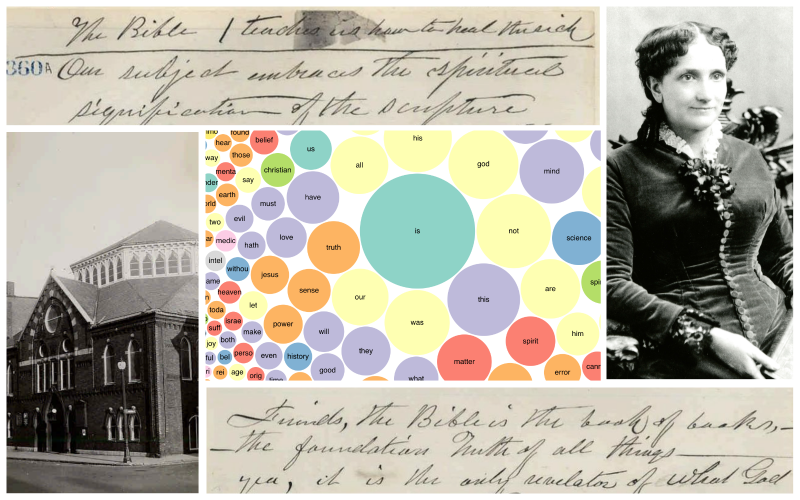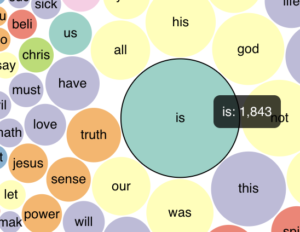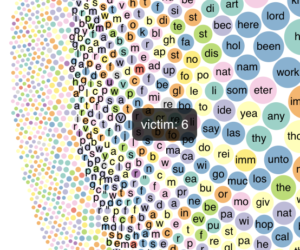From The Papers: Word bubbles, data visualization, and sermons

Manuscript: Mary Baker Eddy, “The Bible Teaches Us How to Heal the Sick,” December 8, 1878. A10360A. Photo: Shawmut Avenue Baptist Church, Boston, c. 1880s. P08918. Photo: Studio portrait of Mary Baker Eddy, c. 1884. P00250. W. Shaw Warren.
This year for Women’s History Month, we thought we would focus on Mary Baker Eddy as Reverend. The Library’s rare and illuminating collection of her sermon texts are enhanced by a data visualization diagram on the Mary Baker Eddy Papers website, exploring the words that she preached.
During her time in the pulpits of rented halls throughout the 1880s, Eddy often preached extemporaneously, or from a few notes or an outline. Other times she wrote out her sermons in full (these form the basis of our diagram). Generally, she would choose a Bible passage for the subject of a sermon and use it to explain an aspect of her theology.
This diagram tells a story of the language that Eddy used in preaching. Each bubble represents a unique word and shows the number of times she used it in the extant sermon texts that we have published on the Papers website. Our team has searched 61 sermons currently available in order to mine these words. In a few cases, these documents include multiple drafts of the same sermon.
Is can be a very big word
What does it mean to use the word is when explaining Christian Science to a live audience? We found that this small active verb was the most common word that Eddy employed in these sermons, appearing 1,843 times. Take her sermon “The Bible Teaches Us How to Heal the Sick.” She delivered it on December 8, 1878, at Tabernacle Baptist Church, which she referred to by its street address: Shawmut Avenue. “Friends,” she opened, “the Bible is the book of books,—the foundation Truth of all things—yea, it is the only revelator of what God is and what God does[.]”1 She used is 43 times in this sermon alone, in different capacities, giving her words an immediacy and energy that no doubt moved her audience.
Names for God
Notice also that Eddy frequently used synonyms for God in her sermons, as she also did in Science and Health with Key to the Scriptures. Here Mind, Truth, Spirit, and Love (shown in all lowercase letters in the bubbles) are some of the most frequently used words. In an undated sermon titled “For God is Love,” Eddy focused on Love as a synonym for God: “We are rejoiced to know ‘that God is Love’ for if spiritual Love is found the Principle of the problem of existence we shall grow into a correct sense of Deity only upon the basis of Love.”2
Tiny bubbles
And then there are the tiny bubbles, representing the words that occur the smallest number of times in these sermons. Victim, interestingly, is one of those words, appearing only six times. (In the diagram, it shows up only as “v,” until you hover a cursor over it.) While this word might seem like a strange choice for a search term, it actually yields interesting results.
Going to the Papers site and searching on victim as a keyword (“Type = Sermon”) on the advanced search page yields five different sermons in which this word appears, with a second draft of “The People’s God” accounting for the sixth instance. Eddy employs victim several different ways. One use in the sermon “Children, have ye any meat?” refers to Jesus as “no longer a victim but vanquished,” in a section about the struggles that the disciples had after his crucifixion. In two sermons (“Matter is but manifest mind and Truth is the master of a lie” and “And why take ye thought for raiment? Consider the lilies…”), she referred to anecdotal victims of sin, whose well-meaning friends want to help them. In “The Science of Life,” she deleted a reference to assassinated Roman emperor Domitian, who had put to death the disciple John, as “the victim of a life misspent.”
The remaining reference to victim also yields an interesting example of Eddy’s editing process as she worked through multiple drafts. In one version of “The People’s God,” Eddy described how she grew in her understanding of God:
When I believed God a person instead of Principle, and was taught those doctrin[e]s of election, even namely, that man is the victim of his Maker I feared God more than I loved Him. but when I learned that God is a Principle and this Principle is Love and Truth I became more the conscious child of God and governed by Truth & and Love — then my health improved[.]3
In an another draft she impersonalized the illustration, using the pronoun we instead of I:
When we believe God a person instead of a Principle and man the victim of his maker we have fear God more than we love Him whereas perfect Love castes[sic] out fear but when we learn that God is the Principle of all being and is Life Truth and Love I we gained a new lease of Life and it has added already to my that includes man’s title to health happiness and longevity[.]4
Later on Eddy published this sermon as a pamphlet. By then she had revised the text even further:
Believing that man is the victim of his Maker, we naturally fear God more than we love Him; whereas “perfect Love casteth out fear;” but when we learn God aright, we love Him, because He is found altogether lovely.5
Follow the bubbles
While this diagram isn’t meant to be definitive, it is an invitation to explore Eddy’s sermons further, and to study her use of language as she explained Christian Science to early audiences. Pick a bubble and then search the Papers website to see where it takes you!
- Mary Baker Eddy, A10360A, “The Bible Teaches Us How to Heal the Sick,” https://mbepapers.org/?load=A10360A
- Mary Baker Eddy, “For God is Love,” A10363, https://mbepapers.org/?load=A10363
- Mary Baker Eddy, “The People’s God, A10371A, https://mbepapers.org/?load=A10371A
- Mary Baker Eddy, “The People’s God, A10371B, https://mbepapers.org/?load=A10371B
- Mary Baker Eddy, The People’s Idea Of God — Its Effect on Health and Christianity (Boston: The Christian Science Board of Directors), 6.





